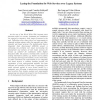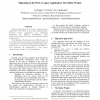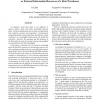WSE
2002
IEEE
14 years 4 months ago
2002
IEEE
Every day, new information, products and services are being offered by providers on the World Wide Web. At the same time, the number of consumers and the diversity of their intere...
WSE
2002
IEEE
14 years 4 months ago
2002
IEEE
As the use of the World Wide Web becomes more pervasive within our society, businesses and institutions are required to migrate a wide range of services to the web. Difficulties a...
WSE
2002
IEEE
14 years 4 months ago
2002
IEEE
Various approaches can be used to migrate legacy applications to the Web. In particular, migrating dataintensive legacy applications (e.g. traditional application for business man...
WSE
2002
IEEE
14 years 4 months ago
2002
IEEE
The World Wide Web, initially intended as a way to publish static hypertexts on the Internet, is moving toward complex applications. Static Web sites are being gradually replaced ...
WISE
2002
Springer
14 years 4 months ago
2002
Springer
WISE
2002
Springer
14 years 4 months ago
2002
Springer
The need of using spatial vector data for web-based and mobile applications has been increasing rapidly. Vector spatial data is difficult to generalise (that is, to derive a suita...
WISE
2002
Springer
14 years 4 months ago
2002
Springer
In this paper, we introduce a novel framework for clustering web data which is often heterogeneous in nature. As most existing methods often integrate heterogeneous data into a un...
WISE
2002
Springer
14 years 4 months ago
2002
Springer
Navigating through a large Web site can be a frustrating exercise. Many sites employ Site Maps to help visitors understand the overall structure of the site. However, by their ver...
WISE
2002
Springer
14 years 4 months ago
2002
Springer
Despite of the popularity of global search engines, people still suffer from low accuracy of site search. The primary reason lies in the difference of link structures and data sca...
WISE
2002
Springer
14 years 4 months ago
2002
Springer
Delta compression techniques are commonly used to succinctly represent an updated version of a file with respect to an earlier one. In this paper, we study the use of delta compr...



